
The Scrophulariaceae are a family of flowering plants, commonly known as the figwort family. The plants are annual and perennial herbs, as well as shrubs. Flowers have bilateral (zygomorphic) or rarely radial (actinomorphic) symmetry. The Scrophulariaceae have a cosmopolitan distribution, with the majority found in temperate areas, including tropical mountains. The family name is based on the name of the included genus Scrophularia L.
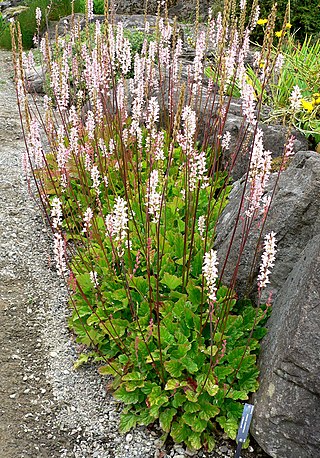
The Francoaceae are a small family of flowering plants in the order Geraniales, including the genera Francoa, commonly known as bridal wreaths. The Francoaceae are recognized as a family under various classification schemes. Under the 2009 APG III system the Francoaceae were included within the Melianthaceae. In the 2016 APG IV system the Francoaceae are again recognized as a family, with Melianthaceae included in the circumscription of Francoaceae.

Amomum is a genus of plants containing about 111 species native to China, the Indian subcontinent, Southeast Asia, New Guinea, and Queensland. It includes several species of cardamom. Plants of this genus are remarkable for their pungency and aromatic properties.
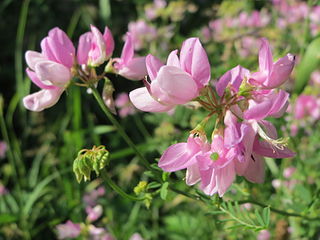
Securigera varia, commonly known as crownvetch or purple crown vetch, is a low-growing legume vine. It is native to Africa, Asia and Europe and is commonly used throughout the United States and Canada for erosion control, roadside planting and soil rehabilitation. It has become an invasive species in many states of the US.
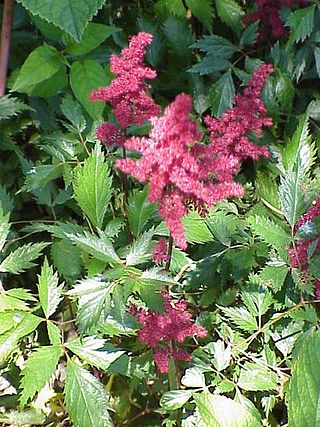
Astilbe is a genus of 18 species of rhizomatous flowering plants within the family Saxifragaceae, native to mountain ravines and woodlands in Asia and North America. Some species are known by the common names false goat's beard and false spirea.

Goodenia is a genus of about two hundred species of flowering plants in the family Goodeniaceae. Plants in this genus are herbs or shrubs, mostly endemic to Australia. The leaves are variably-shaped, the flowers arranged in small groups, with three or five sepals, the corolla bilaterally symmetrical and either fan-shaped with two "lips" or tube-shaped. The petals are usually yellow to white, the stamens free from each other and the fruit a capsule.

Viguiera is a genus of flowering plants in the family Asteraceae. It contains around 19–40 species, which are commonly known as goldeneyes and are native to the New World. These are herbs to bushy shrubs that bear yellow or orange daisy-like flowers.
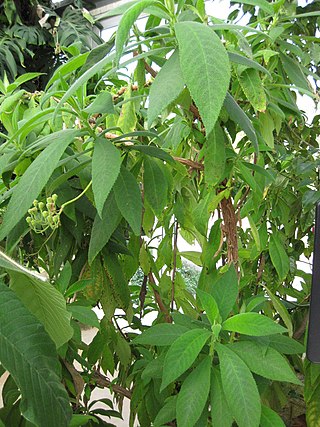
Alloplectus is a genus of Neotropical plants in the family Gesneriaceae. A recent revision of the genus includes five species, with the majority of species in the genus as traditionally circumscribed being transferred to Crantzia, Glossoloma, and Drymonia.

Myodocarpaceae is a family of flowering plants which contains 2 genera and 15 species. The family is accepted under the APG IV system and placed in the order Apiales. In earlier systems the two genera were included among the Araliaceae.
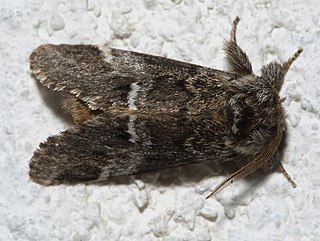
Drymonia dodonaea, the marbled brown, is a moth of the family Notodontidae. The species was first described by Michael Denis and Ignaz Schiffermüller in 1775. It is found in Europe and in the area surrounding the Caucasus.

Drymonia ruficornis, the lunar marbled brown, is a moth of the family Notodontidae. It is found in Central and Southern Europe and Anatolia.

Drymonia velitaris is a moth of the family Notodontidae first described by Johann Siegfried Hufnagel in 1766. It is found in central and southern Europe and Anatolia.
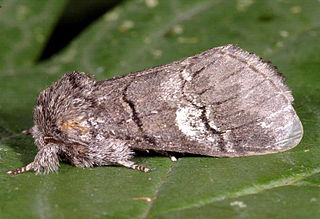
Drymonia querna, the oak marbled brown, is a moth of the family Notodontidae. It is found in the Middle East and mainland Europe except the north.

Drymonia obliterata, the indistinct marbled brown, is a moth of the family Notodontidae. It is found in Central and Southern Europe, Asia Minor and Armenia.

Drymonia is a genus of moths of the family Notodontidae erected by Jacob Hübner in 1819. It consists of the following species:

The family Apodanthaceae comprises about 10 species of endoparasitic herbs. They live in the branches or stems of their hosts, emerging only to flower and fruit. The plants produce no green parts and do not carry out any photosynthesis. There are two genera: Pilostyles and Apodanthes. A third genus, Berlinianche, was never validly published. Mitochondrial and nuclear DNA sequences confidently place the Apodanthaceae in the Cucurbitales, where they also fit well in terms of their flower morphology. The native range of Apodanthes is restricted to Central and tropical South America, while Pilostyles has a much wider though disjointed native range, encompassing many countries in tropical and subtropical America, a section of Africa from Gabon to Tanzania and down to Zimbabwe, as well as Turkey, Iran, Iraq, and Western Australia.

The Gesnerioideae are a subfamily of plants in the family Gesneriaceae: based on the type genus Gesneria. Although genera typically originate in the New World, some species have become widely distributed as ornamental plants.
Drymonia urceolata is a species of flowering plant in the genus Drymonia. It is a climber native to Colombia, Ecuador, and Peru.

Drymonia is a genus of flowering plants in the family Gesneriaceae. It includes 82 species native to the tropical Americas, ranging from southern Mexico through Central America and northern South America to Bolivia and southeastern Brazil.


















